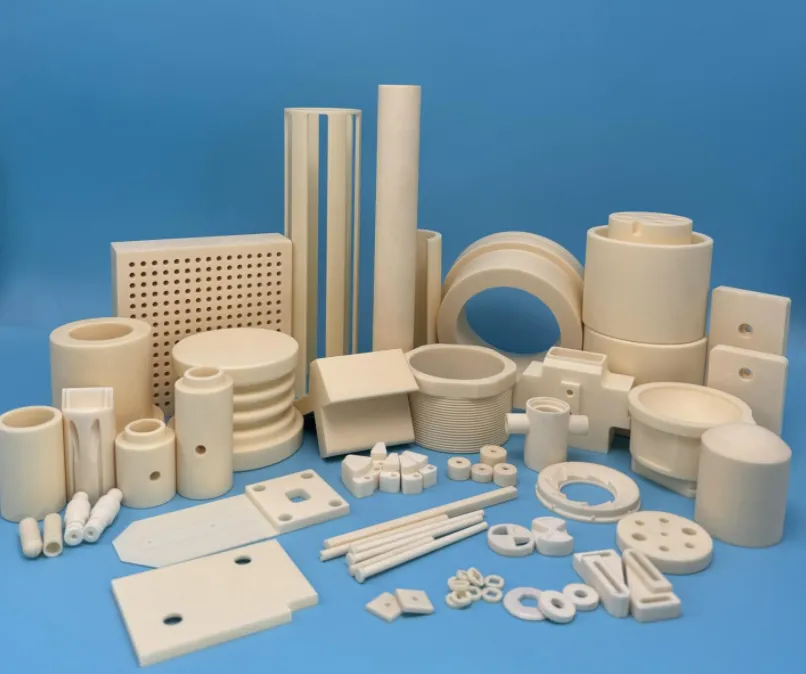The terms "advanced ceramics" and "technical ceramics" are synonymous in most contexts, referring to the same class of materials. They are used interchangeably and are both used to distinguish them from traditional ceramics (such as household ceramics and building materials).
They represent a class of ceramic materials that exhibit specific, exceptional properties through the use of highly refined synthetic raw materials, precisely controlled chemical compositions, and advanced preparation processes.

Some technical ceramics manufactured by Guoci Ceramics.
I. Core Concepts: What Are They?
Advanced ceramics (or technical ceramics) are ceramic materials that are made from high-purity, ultra-fine synthetic inorganic compounds, through precisely controlled molding and sintering processes, and possess specific and exceptional mechanical, thermal, electrical, optical, or biochemical properties.
II. Differences from Traditional Ceramics
To better understand, let's use a table to compare them:
A simple analogy:
Traditional ceramics are like ordinary furniture made from natural wood.
Advanced ceramics are like Formula 1 racing car parts meticulously designed using advanced composite materials (such as carbon fiber).
III. Main Categories (By Function and Performance)
1. Structural Ceramics
-
Core Characteristics: High strength, high hardness, high toughness, wear resistance, high temperature resistance, and corrosion resistance.
-
Key Materials: Zirconia (ZrO₂), Silicon Nitride (Si₃N₄), Silicon Carbide (SiC), Aluminum Oxide (Al₂O₃).
-
Typical Applications: Cutting Tools, Wear-Resistant Parts (Seals, Nozzles), Engine Components (Turbine Rotors, Bearings), Ballistic Armor, Artificial Joints (Hip, Knee).
2. Functional Ceramics
-
Core Characteristics: Utilizes special functional effects such as electricity, magnetism, light, sound, and heat.
-
Key Materials and Applications:
-
Dielectric Ceramics: Used in the manufacture of integrated circuit boards and capacitors (MLCCs).
-
Piezoelectric Ceramics: Used in the manufacture of sensors, actuators, and transducers (such as ultrasound probes and lighters).
-
Semiconductor Ceramics: Used in the manufacture of thermistors, varistors, and gas sensors. Transparent ceramics: Used in lasers, transparent armor, and lighting (high-pressure sodium lamps).
-
Superconducting ceramics: Used in magnetic levitation and magnetic resonance imaging (MRI).
3. Bioceramics
-
Core Characteristics: Excellent biocompatibility, allowing them to coexist with human tissue or promote tissue regeneration.
-
Key Materials: Alumina and zirconium oxide (used in load-bearing prostheses).
-
Typical Applications: Dental implants, artificial bones, and joint prostheses.
IV. Why are they so important? (Core Advantages)
Performance Designability: By varying the composition, microstructure, and processing, materials can be "customized" with specific properties to meet extreme application requirements.
Excellent Mechanical Properties: Extremely high hardness, wear resistance, and compressive strength.
Excellent Thermal Properties: High melting point, low coefficient of thermal expansion, and good thermal shock resistance enable operation at high temperatures that metals cannot withstand.
Unique Functional Properties: Possessing properties not found in metals and polymers, such as ferroelectricity, piezoelectricity, semiconductors, and superconductivity. Excellent chemical stability: Corrosion and oxidation resistance, with extremely long life in harsh environments.
V. Application Overview
-
Electronics and Semiconductors: Chip packaging substrates, insulators, capacitors, sensors.
-
Aerospace: Engine turbine blades, thermal barrier coatings, and spacecraft nose cones.
-
Healthcare: Artificial joints, dental restorations, surgical tools, and medical imaging equipment components.
-
Industrial Machinery: Cutting tools, wear-resistant parts (seals, bearings), and high-temperature furnace components.
-
Automotive: Oxygen sensors, catalytic converter substrates, engine components, and battery separators for new energy vehicles.
-
Energy and Environment: Solid oxide fuel cells (SOFCs), nuclear reactor fuel pellets, and solar thermal power generation receivers.
-
Military and Defense: Ballistic armor, missile fairings, and radar-transparent materials.
Advanced ceramics/technical ceramics are one of the cornerstone materials of modern high-tech industries. They are no longer the art of "clay and fire," but the science of "powder and process." They break through the performance limits of traditional materials and enable the development of technologies. From chip carriers in smartphones to rovers exploring Mars, these extraordinary materials are indispensable.

